Tokyo Story
Main Page
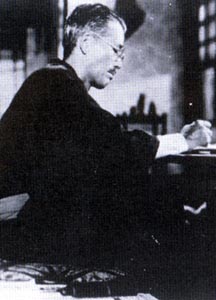
I portray what should not be possbile as it if should
be possible, but Ozu portrays what should be possible as if it were
possible, and that is much more difficult.
--Mizoguchi Kenji
It is often said that Ozu brings "everydayness" to us in his films. While he may seem quintessentially Japanese, he is also universal because living life everyday happens everywhere around the globe. "We" love Ozu and we love to study him, the "we" being non-Japanese specialists who study and try to learn from things Japanese. Why is Ozu to special to us? He has a very distinct and distinctive style: he favors the fixed camera shooting from a low angle--close to the floor where Japanese people live--and with his favored 50mm lens which flattens things out and creates surface space. Shots in Ozu films are like a rich tableau; they also define a space into and out of which the characters move. When people talk about "classical cinema" they are talking about stylistic rules or norms that are associated with a certain mode of industrial production. We often talk about the Hollywood classical style, continuity editing the the shot-reverse-shot manner of narative construction typical of the Hollywood style. People enjoy Japanese cinema because it is traditionally thought of as an “other” to Hollywood classical cinema, exhibiting a stylistic alternative to the narrative realism associated with the American industry. Japanese cinema is a stylish cinema. We often say that it is beautiful, elegant and extraordinarily well-crafted. Subtle, delicate, but deep and intense. "Japanese films often have a consistency of elegant composition, skillful figure placement and use of architectural and lighting design. Also, for us, as students of film, Japanese cinema can seem exotic. Japanese films have a richly poetic vocabulary and universal themes of progressive humanism. But its aesthetics distinguish it from American and European film practices—auterist in structure with links to cultural traditions. The stylishness of the visual field indicates a cultural impetus to aestheticize, to raise the status of everyday life to something more meaningful, more harmonious and more beautiful than, in truth, it really was or could be. At the same time it is a realist cinema that demonstrates a keen eye for detail, for both the modern world and the historical." (See Catherine Russell, Classical Japanese Cinema, 2011, p. xiv)
We like Ozu, then, because he offers our eye something different from the standard Hollywood fare. On the other hand, one can say that hardly anything "happens" in an Ozu film other than the passage of time. That does not mean that Ozu's film are about "nothing." They are always about change, about transformation, about family, about growing older, about the fast-paced urban life in contrast to the slower pace of rural life. Which is why Japanese films, and Ozu films, are a great way to think and talk about modernity because film is very much a part of modern life. As Catherine Russell notes, the "discourse" on Japanese modernity is about the "cultural formation of heterogeneous styles, subjects, discourses and desires. The very question of what is 'Japanese' is negotiated in modernity; what one can expect from modernity and how it is experienced are implicit in every film." (Russell, Japanese Classical Cinema, p. xiii). Also, the film industry grows up with young, modernizing societies. Japan had a thriving film industry with a substantial consumer market from the 1930s onward. But many would say that the real "golden age" of Japanese film comes in the 1950s, in the postwar years, because during the latter part of the 1930s, everything in Japan became subservient to the state and its wartime needs. With the end of the war and the introduction of a new constitution and democratic freedoms, directors and writers were more free than ever to pursue and develop topics of inteerst to them. Another rerason why we enjoy studying Japanese film is that like European film in the 1950s, it is an "auterist" driven medium where often the director is the scriptwiter, or collaborates closely with the screenplay writer, so the final product is seen as the product of the director-writer's worldivew and aesthetic impulse. This is not necessarily something to which American filmgoers, raised on Hollywood cinema, were very accustomed.
As Audie Bock mentions, the subject matter of the Ozu film is what faces all of us
born of man and woman and going on to produce offspring of our own: the family.
. .[B]ehind the words [shomin-geki and home drama] are the problems
we all face in a life cycle. The are the struggles of self-definition, of
individual freedom, of disappointed expectations, of the impossibility of
communication, of separation and loss brought about by the inevitable passages
of marriage and death.
Over the years of his lengthy filmmaking carer, from 1927 to
1962, Ozu honed, pared down, refined his form to a spare essence allied with
the devestatingly simple, everyday problems his characters face. Just as the
situations and the people themselves became archetypes, the cinematic technique
became a reduction to present, linear time, to sequences based on a "primitive
cinema" format of long-shot, medium-shot, closeup, and back again, to
camera and editing work that rejects movement and that smacks of virtuosity.
What remains after all the pruning is an anti-climactic, slow-paced, and deeply
moving revelation of character that fulfills the Mises van der Rohe maxim
"Less is More."
. . .As different as Ozu's system is from Mizoguchi's traveling
camera shooting in ever-changing angles, it allows the same implications of
space and environment transcending human presence. Sets are usually empty
but for a few frames before the characters enter, and remain empty after they
leave. In employing the set like a curtainless stage Ozu allows for implication
of transitoriness in the human condition. Allied with the other aspects of
ritual in Ozu's techniques, it reinforces the feeling that we are watching
a representative life cycle.
Extending space yet farther beyond the human presence are
Ozu's still-life punctuations. Shots of water tanks, smokestacks and laundry
fluttering on backyard clotheslines recur in all his films. They are emotional
rest-stops, outside the point of view of any character in the story and
reminders of mundane continuity at the same time as they remind us of human
transciency. . .
--Audie Bock, Japanese Film Directors, pp. 71; 83
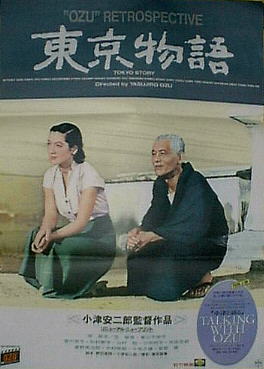
Tokyo Story was released in 1953 and can be seen as "the canonical film about the difficult rebirth of modern Japan. Japanese film had only just been coming to the attention of international film critics. Kurosawa's Rashomon had won the Best Picture Award at the Venice International Film festival the year before, and Mizoguchi's films were starting to be seen in Europe. The story of aging parents and an emerging generation gap is mapped onto the split between rural and city life symptomatic of modernization. A simple plot, to be sure, but Ozu had faith that "everyday life, rendered tellingly, provides more than enough drama to engage us deeply." (David Bordwell, Criterion Collection Notes) On many levels this is a 'universal' story with deep currents of human emotion. The complicated relationships between parents and their adult children have rarely been so senitively handled. and yet, as the "title suggests, Tokyo Story is also very much about one city at one moment in time and dwells on a level of historical specificity that is equally crucial to its lasting effects. Ozu's particular means of treating historical change and transition rests on a sense of resignation to the loss of old ways, and a certain anxiety about what the future holds. At the same time, Tokyo Story is examplary of the director's idiosyncratic use of film style, ironically displaying a mastery of modern film language." (Catherine Russell, Classical Japanese Cinema, p. 41) As David Bordwell puts it in his notes to the DVD issued by Criterion, "Thanks to Ozu's compassionate detachment, the final scenes take on enormous richness of feeling as we watch characters contemplate their futures....Shukichi greets a beautiful sunrise...An ordinary wristwatch links mother, daughter, and daughter-in-law in a lineage of hard-earned feminine wisdom. And the roar of a train dies down, leaving only the throbbing of a boat in the bay." Somehow, though, what Ozu offers a well-balanced, internally coherent film that is, in Russell's words, "a national allegory." "This is not just the story of Tokyo; it is the story of postwar Tokyo, a tale of the family of Japan trying to find the way forward after the 20-year turmoil of war and occupation." (42)
See a Nice NYT Video Review by A.O. Scott
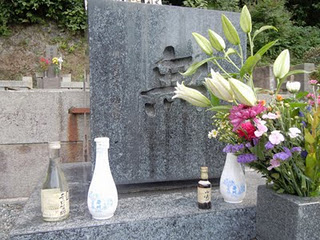
Ozu's grave with the Chinese character "Mu" 無--nothingness--engraved
Ozu: Poet of the Everyday
"One of the greatest artists of the twentieth century in any medium
and in any country."
- British Film Institute
"Ozu’s body of work is incommensurable with that of any other
Japanese filmmaker except perhaps Kurosawa...As a contribution to Japanese
culture, however, it is comparable only to that of the great poets, painters
or sculptors of the past."
- Noël Burch
Recognized in the west today as one of the greatest of all Japanese filmmakers,
Yasujiro Ozu (1903-1963) directed a total of 54 films. More than half of the
thirty silent works he created remain lost.
What audiences new to Ozu’s universe will encounter is the work of a
director exquisitely sensitized to the emotional latticework of human relations,
most particularly those within the family. Perhaps no other filmmaker is so
attuned to "the ties that bind," so able to evoke the poignancy
of everyday heartaches and challenges, so skilled at capturing epiphanies
amidst the commonplace, always with the unforced attentiveness of a great
listener. Generally regarded as a director whose specialty was the "home
drama," Ozu also directed films of social criticism, satires, melodramas,
and even a gangster film. Regardless of the genre, however, human beings are
privileged over narrative intricacies. As the director himself noted, "Naturally,
a film must have some kind of structure or else it is not a film, but I feel
that a picture isn’t good if it has too much drama or too much action."
Often lauded for their restraint and ‘simplicity,’ Ozu’s films
are, in fact, like all great works of art, endlessly revealing in their insights
and possessed of numerous subtle complexities both stylistic and thematic.
Whether they focus on the interaction of the old and the young or male and
female, or the contrasts between the workplace and the homelife, or tradition
and change, Ozu’s observant eye has the rare power to draw the sympathetic
viewer into unique emotional terrain. In the best of his work—and there
are many titles that would fall into the category—he attains poetry.
– John Gianvito
TOKYO STORY
Tokyo Monogatari Japan 1953 (134 min)
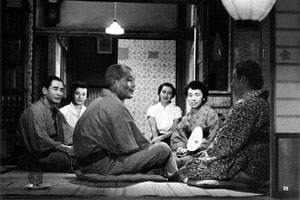
Ozu’s sad, simple story of generational conflict is often regarded as
the filmmaker’s
greatest masterpiece. In fact, in Sight and Sound’s 1992 once-a-decade
poll of
international film critics, it was chosen as one of the top ten films of all
time, outpolled
only by Citizen Kane and The Rules of the Game. An elderly couple’s
visit to various
busy, self-absorbed offspring in Tokyo is met with indifference and ingratitude,
only
serving to reveal permanent emotional chasms. Ozu’s examination of the
slow fracturing
of the Japanese family is filled with quiet resignation, and the realization
that tradition is
subject to change. Melancholic, spare and restrained, Tokyo Story is
a meditation on
life, love, and mortality.
Directed by Yasujiro Ozu with Chishu Ryu, Chiyeko Higashiyama
and Setsuko Hara (Japanese with English subtitles, b/w, 35mm)
The action is limited. An elderly couple travel from their home in Onomichi,
a small coastal community near Hiroshima (see alsohere), to visit their grown children in Tokyo.
It's their first trip their but it is tinged with disappointment which is what
gives the film its melancholy tone. For a detailed discussion of the film, see http://www.um.u-tokyo.ac.jp/dm2k-umdb/publish_db/books/ozu/english/05.html
where Yoshitsugu Horike makes the argument that:
His first films, without sound and heavily influenced by Hollywood films
of the period, were distinctly non-exotic. However, since he established
himself long before the fifties internationalism, he later felt no need
to cater to the exoticism of western critics. Such innovations as the cut-back/reverse
shot sequence were uniquely Ozu's and resisted any quick iconic-cultural
identification, American or Japanese. It was only later, after a long of
period of misunderstanding and re-acquaintance, that his rather personal
and subtle style become widely admired. So peculiar and personal a style
it is that it fully deserves the appellation, "Ozuism."
It is true that today Tokyo Story is as respected and well known as Ugetsu
and Rashomon. But it is admired, I think, because of this unique
style, this Ozuism. It is a style that permeates the film and overflows
it. Indeed, it is as if this style itself becomes the norm and subject of
the film.
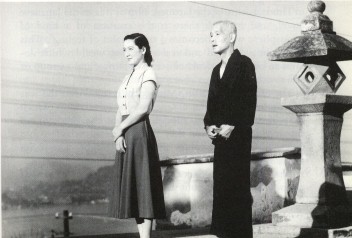
To experience a Yasujiro Ozu film is to immerse in the reserved, quiet grace of a disappearing traditional culture. Tokyo Story is a languidly paced, subtly poignant, and exquisitely realized story of the Hirayamas, an aging couple from the provincial town of Onomichi who travel to postwar reconstructed Tokyo in order to visit their children, who, in turn, seem to have little interest or time to be with them. Their pediatrician son promises to take them sightseeing through Tokyo, only to be called away on an emergency. Their daughter Shige (Haruko Sugimura) promises to take them to the theater, but cannot leave her beauty salon. Only their widowed daughter-in-law, Noriko (Setsuko Hara), seems genuinely pleased to see them, and takes a day off from work to show them around Tokyo. Not knowing how to entertain their parents (and to save money), the siblings decide to send them to a noisy, crowded spa. Unable to enjoy themselves, the elderly couple return early, only to be sent away for the evening when their unexpected arrival interferes with Shige's scheduled club meeting. Consequently, Mrs. Hirayama (Chieko Higashiyama) spends a final evening with Noriko before heading back to Onomichi, and Mr. Hirayama (Chishu Ryu) finds some old friends in town, hoping to be invited to spend the evening, but in the process, gets hopelessly drunk. On the following day, Mrs. Hirayama offers the adult children some words of reassurance at the train station, and the couple leave. There are no external catalysts in the film, no psychological deconstruction of a dysfunctional family. It is a story about generational fractures - culture, tradition, and people - left in the wake of modernization and consuming self-absorption.
Ozu uses low camera height and breaks the rules of conventional cinema using 360° space, creating an intimate, familial atmosphere, to draw us into the lives of the Hirayama family - through subtle gestures and mannerisms, mundane conversations, daily rituals, and simple acts of kindness. Throughout the film, there is a pervasive sound of movement: ticking clocks, churning steamboats, passing trains. Yet within each framed composition, Ozu's camera does not move (there is only one tracking shot as the camera moves from a brick wall to the image of the evicted elderly couple). It is a figurative reminder that modern life is in perpetual motion, and that the beauty of life is often found in standing still. Tokyo Story demands little from the viewer, except to sit back and absorb the sweeping, beautiful images that gradually unfold before us towards its muted, heartbreaking conclusion, and from it, derive meaning for our own frenetic existence. But, in the culture of fast cars, internet access, and prescription panaceas, that is, perhaps, too much to ask.
See also a Guardian film Review at:
Roger Ebert wrote a nice review of the Leo McCarey film, Make Way for Tomorrow, which is written about in Ch. 2 of Desser's book.
And another Review:
Tokyo Story
(Dir: Yasujiro Ozu, Starring Chishu Ryu, Chieko Higashiyama, Setsuko Hara, Haruko
Sugimura,
Kyôko Kagawa, Setsuko Hara, Kuniko Miyake, Zen Murase, Teruko Nagaoka,
Nobuo Nakamura,
Hisao Toake, Eijirô Tono, Shirô Osaka, and Mitsuhiro Mori)
BY: DAVID PERRY
Yasujiro Ozu became the icon of the Japanese dramatic film experience
after the long awaited release of his films in America. The best regarded of
his films is Tokyo Story, which was made in 1953 but did not receive
an American release until 1964 -- and the film theorists would never look at
the Sino-cinematic world the same. What was once a land in the East only known
for Kurosawa films would forever have a second bright shining director to establish
a name for the style found there. The Asian historical action films will forever
be referred to as Kurosawa-like; the deep, lethargic movies that are distant
yet tell so mach are Ozu-like.
Ozu's film is a meditation on what it is like to reach that introspective
point in life where you can look at your adult children in either adulation
or disdain. Even more so, though, Tokyo Story takes a sharp look at the
way children outgrow their parents. Using the word 'meditation' is perfect when
writing of an Ozu film, the sturdy and slow way the director films is a testament
to his abilities: where some directors would have created an overlong bore,
Ozu creates something even more enthralling.
The elderly Hirayama's, Shukishi (Ryu) and Tomi (Higashiyama), make the decision
to finally leave their home in the small village of Onomichi and visit their
children who are mainly settled in parts of Tokyo on a 10 day holiday. The two
that they consider to be successes before leaving is one son, a smalltime doctor,
and one daughter, a self-reliant hairdresser. But they can only feel disparage
for their children after a night there -- the Hirayama's are hurt to see that
not only are their children not as successful as was thought, but also that
they seem to have little time of care for seeing their parents. Before long
they have been shuffled off to a spa in Atami -- the kids think that this is
a nice place where their parents will get some rest and be out of their hands.
But the place is crowded and the couple decide to return to Tokyo a day early
only to find that there is no longer any room for them in the houses they expected
to stand open for them. However, as disgraceful as the two blood relatives may
be, the Hirayama's find that they are truly welcomed by their daughter-in-law
Noriko who is now a widow.
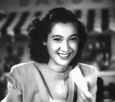
Since they have no real place to stay, Tomi is invited into Noriko's
apartment -- this relative-by-marriage is also the only person who took off
work to show them around Tokyo upon their arrival -- and Shukishi decides to
spend an evening drinking with some old friends and mull over the disappointment
he has seen on this small trip. After visiting their other son in Osaka, the
Hirayama's return home to their youngest daughter who still lives with them
in Onomichi. But a change of plans soon brings the family back together and
all their problems, fears, desires, and distastes come up as they sit at a rather
sad family reunion.
Ozu uses his camera as an innocent bystander, a third person caught amidst all
the people trying to understand each other. While his gives the film a distant
feel -- the camera only moves once in the entire film, and in that case it is
only to show the couple standing alone at the otherwise crowded spa -- it also
makes it ever so intimate. Ozu's characters live and breathe through his direction
and their actions seem more personal and worrisome than would have otherwise
been seen. When the camera does go in for the occasional close-up, the shot
is more important as a chance to show an emotion than to give a break from the
long shots. Nevertheless, because of this longer span from afar, these up close
and personal shots seem more determined to strike the needed chord because they
are such a break in the editing.
The movie is paced rather slowly and clocks in at a surprising 139 minutes,
yet each moment, each passing glance seems important in the film. No matter
what the running time is, Ozu has captured a film so remarkable that each frame
seems tantamount to the story in some way, whether it be for pacing, continuity,
or mood. Ozu sets his sights on just the right parts of a realistic storytelling
structure and makes the most out of it. Generations of Japanese filmmakers have
learned from Ozu -- even Kurosawa became a bit of a devotee into his elder years
-- and his touch is seen on countless movies these days. The last film to successfully
capture the spirit of Yasujiro Ozu was Edward Yang's Yi Yi (A One and a Two...),
unquestionably one of the finest films to come from Asia in years. I remember
the pure emotion that I felt when I finished Yang's film, a feeling that is
also found in Ozu's films. Finishing Tokyo Story is like finishing a
deep allegorical poem -- its lyricism fills the air with a stunning realization
of everything that it aspires to be. When the final title card comes up to tell
the audience that the film has come to an end, it is hard to imagine a world
without the magic that just transpired on the screen in front of them.
Related Works:
Barret, Gragory. Archetypes in Japanese Film. Selinsgrove,
Pa. : Susquehanna University Press, 1989.
Bock, Audie. Japanese Film Directors. Tokyo: Kodansha International,
1978.
Bock, Audie. "Ozu Reconsidered." Film Criticism (Fall 1983):
50-53.
Bordwell, David. Ozu and the Poetics of Cinema. Princeton, N.J.: Princeton
University Press, 1988.
Hibbitt, Howard, ed. Contemporary Japanese Literature: An Anthology of Fiction,
Film and Other Writings since 1945. New York: Knopf, 1977.
Konshak, Dennis J. "Space and Narrative in Tokyo Story. " Film
Criticism 4, no. 3 (Spring 1980):31-40.
McDonald, Keiko I. Cinema East: A Critical Study of Major Japanese Films.
East Brunswick, N.J.: Associated University Presses, 1983.
Osamu, Takahashi. "Brilliant Shadows: Ozu Yasujiro (1)." Japan
Quarterly (July-Sept. 1984): 269-277. "Brilliant Shadows: Ozu Yasujiro
(2)." (Oct. Dec. 1984): 435-444.
Ozu, Yasujiro. "Tokyo Story." Translated by Donald Richie and Eric
Klestadt. Contemporary Japanese Literature, edited by Howard Hibbett.
New York: Knopf, 1977.
Reader, Keith. "Inscrutability and Reproduction—Four Major Japanese
Directors." In Cultures on Celluloid. London: Quartet Books, 1981.
Richie, Donald. "The Later films of Yasujiro Ozu." Film Quarterly
13 (Fall 1959): 18-25.
Richie, Donald. "Yasujiro Ozu: the Syntax of His Films." Film Quarterly
18 (Winter 1963-64): 11-16.
Schrader, Paul. Transcendental Style in Film: Ozu, Bresson, Dryer. Berkeley:
University of California Press, 1972.
Or, as another reviewer sums it up:
This is not a film about plot. It is a film that explores
the
relationships between the generations with warmth and subtlety and
gentleness, though the conclusion must be accepted as a very
contemporary, alienated view. Ozu comments, too, on changing mores
from generation to generation.
The acting is superb throughout, emotions conveyed powerfully by
as little as a swallow or a turn of the head, a handkerchief held in a
hand. The film is full of feelings, all understated, all with the tenor
of
universal truth. Ozu looks at and reflects on parent's expectations of
children and children's expectations of parents, and then weighs the
expectations against the realities. By the time we spent over two hours
with this family, we felt we knew them and we surely cared about them
and were deeply moved.
- Arthur Lazere
See also this review by Dennis Schwartz:
"This very well might be the best film ever made."
Reviewed by Dennis Schwartz
http://www.sover.net/~ozus/tokyostory.htm
For a Westerner to watch a Yasujiro Ozu film is to have a totally different film experience than conditioned by Hollywood. Ozu's films were greatly appreciated in his country, but in the west have reached critical acclaim with only select audiences. Don't expect an action or sentimental or special effect film, or one with fancy camera movements, fades, dissolves, pans or tracking shots. Ozu turned out powerful and beautiful and emotionally gripping films, mostly in b/w (his first color film was in 1958), and never made one that lacked a lyrical quality. In Japan, he was considered the most Japanese of all the national directors. His scenes were shot in 180-degree cuts and in a circular 360-degree space, which made for dramatic visual effect. Ozu is the master of using space as poetry. His camera is always still and he never uses low angle shots, as the camera remains positioned about 3 feet off the ground. That corresponds with the eye-level of an adult sitting on a meditation cushion, as is the customary way for the traditionalists to be seated. He's also fond of trademark shots, such as a train pulling into a station and shots of emptiness, where he waits for his characters to walk into that space. His emptiness represents the Buddhist eternal no-thing-ness and the characters represent the temporary concerns of this world, that include their life long attempts to wrestle with living a full life and its disappointments. The characters through their personalities become the central figures of Ozu's profound vision, while their stories remain almost entirely undisturbed by any extras or need for stylization. The master director made 54 films in his long career before his death from cancer in 1963, at age 60.
Tokyo Story is reputed to be his favorite, and is the best known of his films in the States because it was more widely distributed than his others. In my way of thinking, one could not go wrong to use Ozu as a measure or a model against other filmmakers. He might arguably be the best filmmaker ever. But, if not, he's certainly one of the best and despite his attention to Japanese lore he still has a universal appeal. His perfect films, even if not thought so by those demanding a more flashy storyline and gloss, are standards for that art form just like Charles Dickens is for literature, Goya for art, Milton for poetry, and Beethoeven for classical music. These are all artists who can reach both a wide democratic and an elitist high-brow audience, as there is an entry level to their work at all stages.
Tokyo Story opens as an elderly middle-class couple Shukichi and Tomi Hirayama (Chishu Ryu & Chieko Higashiyama) are leaving their sleepy traditional seaport town of Onomichi to visit in Tokyo two of their children, their eldest pediatrician son Koichi (Sô Yamamura) and their next oldest beauty salon owner daughter Shige Kaneko (Haruko Sugimura), who are a day and half away by train. They have lost contact with their successful career-minded children, and since the couple is getting up in the sixties they are interested in seeing them again before it's too late and also seeing how bombed-out Tokyo has been rebuilt since the war. They leave their youngest daughter Kyôko, a school teacher, at home, and meet their busy youngest son Keizo in Osaka at the station as the train makes a brief stopover.
Their doctor son lives on the outskirts of town and is a neighborhood doctor with a busy practice, but not the big-shot physician they assumed. Their two grandchildren, Minoru and Isamu, are emotionally unreachable. Minoru squawks that he has no place to study with their visit, while their father gets called on an emergency and can't show them the town on Sunday--his only day off. The wife can't leave the children alone and they're so concerned with money that they can't spring for a babysitter, so the grandparents remain homebound. Soon the doctor palms his parents off to his sister's house, but she proves to also be too busy to take them out. She's also more overtly selfish, as she chides her husband (Nakamura) for buying expensive cakes for them and sees to it that they don't get it as she stuffs them down her throat before they arrive. Shige asks their daughter-in-law Noriko (Setsuko Hara), who married their oldest and has been a widow for the last 8 years when he died at war, if she can take the parents out. Noriko is really glad to take them out and gets permission to take the day off from her office job--the only host who bothers to take a day off. She's the poorest and not a blood relation, but she makes the time to show them the typical tourist sights and doesn't have a selfish bone in her body though she thinks she has some selfish faults that don't show like forgetting occasionally about her dead husband. The parents apologize to her for the inconvenience, and while thanking her for being so generous and honest they let her know that their son was far from perfect and she must have had some difficult times with him.
Shige plots with her brother to chip in and dump the folks in Atami, a hotel hot spa mainly catering to the younger generation but not that expensive, as the two selfish children are more interested in their careers than in seeing their parents. The grandparents find the place noisy and can't sleep and decide to go home tomorrow, but when they return to Shige's to stay for the night they are not welcomed back because she has some beauticians meeting over the house and is too embarrassed of her folks to be seen with them. Feeling homeless, the parents kill time in Ueno Park and wait for Noriko to get home from work. Mother stays with Noriko and takes heart in the kind-hearted daughter-in-law, and in a genuine way urges her to remarry. Her happiest time in Tokyo is this night visit with Noriko and their refreshing heart-to-heart talk. Meanwhile Father goes out at night with Hattori, a resident of Onomichi who moved here 18 years ago. The two old time drinking buddies haven't seen each other since, and meet another transplant from their hometown and get stinking drunk while they reminisce. Hattori also talks about his disappointment with life and his children, but Father doesn't blame the children for his disappointment in them saying that's life. He looks on the positive side that they're better than most children. When the drunks leave the bar a policeman takes Father and Hattori back to Shige's house to sleep it off, and the drunken parent is reprimanded by his nasty daughter for straying again into drink. The next day the grandparents go home, but on the train Mother gets sick and when they reach home she's bed-ridden in a coma. All the children and Noriko come for the death-vigil, but the son in Osaka delays the visit for selfish reasons and arrives after she died. Shige is the first to cry openly, but the tears seem to be both sincere and for herself--as one can't get past her selfish nature even when she cares. At the Buddhist funeral, the chants get on Keizo's nerves and he exits unable to face his guilt for ignoring his mother all his life. All three children make a quick exit after the funeral, with Shige shamelessly making off with some of her mother's clothes. Only Noriko stays behind and keeps the lonely Father company, as he greets a gorgeous sunrise--signaling a new day but still another hot one. Father and Noriko share a beautifully tender scene together as he presents her with Mother's wristwatch--which greatly touches her and links Mother and daughter-in-law with a well-earned feminine wisdom.
There's hardly a story or much to decipher psychologically, but everything is so real that you feel part of the family and relate to the unforgettable characters as if they were perhaps your family or friends or neighbors. You are drawn to their mundane everyday lives, subtle gestures of kindness, and daily rituals. There's even a few comic moments thrown in, like all the passenger heads bobbing up and down in unison while on a sightseeing tourist bus ride through a bustling Tokyo. All the film's greatness is in getting even the smallest of details exactly right and in the overwhelming emotional pronouncements, and in the compassion Ozu shows for all the characters. It's a sad story about the end of the older generation, a generation that has passed out of favor due to the new industrialization and the way the modern houses are built without the need for meditation rooms to relieve the stress. The transitional generation, represented by the selfish children, has gone through great change brought on by the lost war. That generation is already distant from the generation to come represented by the estranged grandchildren growing up in a world of industrial smoke stacks and skyscrapers and need to learn English. Their world no longer resembles the world of their traditionalist grandparents or hardworking parents, but beckons to an unknown future that is represented by all the clicking sounds from the clocks marking off the rapid passing of time. There's no American multiplex showing a similar family-styled melodrama that can match this film for intensity and breath of scope and honesty of character. This very well might be the best film ever made, as this review only skims the surface of its depths. In a 2002 Sight & Sound international critics' poll, Tokyo Story was ranked as one of the ten greatest films ever made.
REVIEWED ON 12/9/2003 GRADE: A+
Dennis Schwartz: "Ozus' World Movie Reviews"
© ALL RIGHTS RESERVED DENNIS SCHWARTZ
See also a more detailed Ozu Bibliography at





